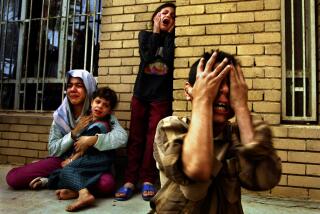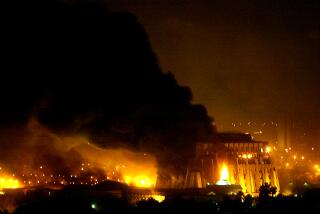Iraqi ‘Marsh Arabs’ Struggle to Survive : Middle East: Ancient ways still exist in this watery homeland in southern Iraq. But Saddam Hussein is trying to destroy inhabitants’ Garden of Eden.
- Share via
Adam and Eve once lived among their reed banks, according to traditions of the 50,000 people who occupy the marshes and swamps of southern Iraq.
Now the “marsh Arabs” themselves are threatened with being driven out of their Garden of Eden, despite efforts of the United States and its allies to protect them from air attacks.
U.S. officials say that Iraqi President Saddam Hussein has been waging environmental as well as military warfare against the marsh Arabs in his efforts to dislodge them from their watery lands. His purpose, they say, is to isolate and ultimately destroy about 10,000 armed insurgents who have taken refuge in the marshes.
Continued attacks on the environment, such as draining marshlands and poisoning the remaining water, would be harder to spot by surveillance flights of U.S. and allied aircraft, which began Aug. 27, than would overt military action.
In a homeland of haunting, primeval beauty, many of the predominantly Shiite Muslim people who call themselves the Ma’dan cling to the rudimentary agricultural lives their forebears have led since humans first came to the region at least 5,000 years ago.
The scene of conflict is a misty delta, smaller than New Jersey, where the Tigris and Euphrates rivers overflow across the flat countryside before uniting as the Shatt al Arab and emptying into the Persian Gulf.
“It’s a perfect place for an insurgency to bubble up and survive,” said Jim Kelly of Baltimore-based Catholic Relief Services. “It’s equivalent to the jungle of Southeast Asia. It’s very easy to hide and very difficult to track people and catch them.”
U.S. officials say satellite intelligence photographs show that entire villages in the marshes have been destroyed by artillery, bombing and strafing. Photographs also show causeways that have been built through the marshes to allow movement of heavy military vehicles.
According to recent reports from people in the area, Iraqi soldiers also have been targeting the environment, poisoning water in suspected insurgent strongholds, burning vast stands of reeds that could provide cover and draining waterways to limit boat travel and facilitate military movements.
Iraq manipulated water resources during the Iran-Iraq war, draining areas of the marsh to discourage smuggling, infiltration and subversion, and at one point creating a lake to block an invasion route.
U.S. officials suspect that Hussein now may be using the giant Third River hydrological project to lower the water level in the swamps and as an excuse to build military roads through the area.
The Ma’dan travel their province of lagoons, banks and island villages in shallow dugout canoes of antique design. They raise water buffalo and sheep and a little rice.
Although some of the marsh people are Sabaeans, a pre-Islamic sect, most are Shiite Muslims who Baghdad believes are sympathetic with the insurgents. There is evidence that the rebels also receive some aid from neighboring Iran, a Shiite nation. Iraq is 55% Shiite, but minority Sunni Muslims control the government.
For centuries, vast ranges of water and reeds kept the marsh people sealed off from the outside world. This isolation makes the marshes both an ideal refuge for the rebellious and defeated and a cultural sponge that has absorbed diverse peoples over the millennia.
More to Read
Sign up for Essential California
The most important California stories and recommendations in your inbox every morning.
You may occasionally receive promotional content from the Los Angeles Times.










